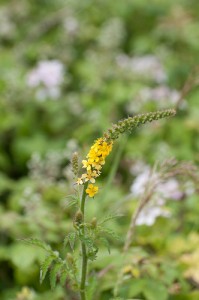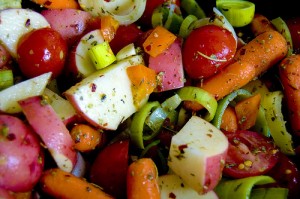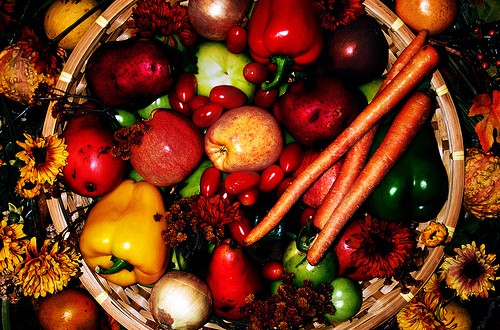by Michelle Sutton-Kerchner
The deep, rich colors of fall reflect nutritious super foods. Enjoy autumn’s rainbow on your plate. And, discover the secret to controlling your appetite when apple pie becomes a fall obsession …
Dark colored produce often has the most nutritional punch. And fall is the season for these super foods. Just think of cranberries, pomegranates, and grapes. You’ve got autumn’s palate in your neighborhood farms. Take advantage. Feed your body these top choices at their peak of freshness.
Your Dinner Table’s Fall Landscape
Sweet potatoes: From late summer through wintertime, these are potato lovers healthier option. Sweet and white potatoes contain a similar carbohydrate count, but sweet potatoes have the perk of more fiber. Treat them as you would their white counterpart. Top with a heart-healthy butter alternative, smash them, bake them, or make them into French fries.
Pomegranates: In season from October through December, these are a delight although a bit of a hassle to prepare. The fruit of the pomegranate is buried in a fleshy pulp. Soak the entire inside “package” to help loosen these tiny gems from the pulp. Then, enjoy topped on salads, plain yogurt, or by themselves. They are similar to cranberries but not as tart.
Loaded with vitamins C, K, and fiber, pomegranates are thought to slow the growth of prostate and lung cancers. They also may lower cholesterol levels for a healthier heart.
Apples: The esteemed apple is fall’s symbol. Find them on decorations, in pies, and scented in candles. With a wide range of flavors from tart to sweet, apples can do everything from top chicken in a chutney to dip in caramel as a Halloween treat.
Apples’ fiber content is helpful for gastrointestinal upset, both constipation and diarrhea. They have anti-cancer properties, particularly in their skin. Speaking of skin, Granny Smith and Red Delicious versions help maintain youthful skin with their abundance of collagen and elastin. Crunch on raw apples and allow their antioxidants to prevent wrinkles and promote healthy hair growth. The cleansing power of apple cider vinegar rids skin of oil and bacteria to prevent acne.
Pumpkins: Considered a winter squash, fall is their season to shine. Light them up as a Halloween decoration, seed for snacking or roasting over a campfire, use their flesh for pie. These may be the season’s most versatile offering.
Bright orange in color shows pumpkins are packed with the antioxidant beta-carotene. Research indicates foods high in beta-carotene may reduce cancer risk and protect against heart disease. Some other perks: Virtually fat-free on their own, pumpkins are loaded with vitamins A and C, calcium, iron, and potassium. No wonder we still sing about pumpkin pie during the December holidays. Pass it around. (Warning: The whipped cream may be a detriment.)
A Note to Fall Allergy Sufferers
When seasonal allergies strike, beware of cross-reactive foods. Depending on your allergy, certain foods during that season can exacerbate symptoms. Using the fall as an example, someone allergic to ragweed may wish to avoid bananas, cucumbers, zucchini, and melons because they contain proteins similar to those found in the pollen ragweed. For the same reason, apples and kiwi may be problematic to those with a mugwort allergy in late summer/early fall.

According to the American Academy of Family Physicians, these symptoms are likely caused by oral allergy syndrome. People allergic to pollens may experience cross-reactivity at their peak allergy season to proteins found in certain fruits and vegetables that are similar to those in the pollens. Along with sinus symptoms, one may suffer itchiness and swelling of the mouth, lips, and tongue after eating the offending fruits and vegetables.
Once cooked, the protein that cross-reacts with pollen changes from the heat and should not trigger oral irritation. Therefore, soups and food products that contain the offending produce, like ketchup and sauces, usually can be enjoyed without worsening your pollen allergies.
If additional symptoms are not confined to the mouth, but include rash, difficulty breathing, vomiting, or dizziness, a food allergy may be the cause. Seek immediate medical attention.
In the heart of your sneezing season, it is helpful to recognize and avoid these potential triggers. After your allergy season, issues with cross-reactive produce should subside as well. Determine which pollens, if any, affect you and try to eat accordingly.
Food Armor to Fight Colds & Flu
Mushrooms nicely embellish a variety of dishes. They usually absorb the flavor of the entree in which they are served. Surprisingly, they also may protect against colds and flu. The basic white button mushroom contains polysaccharides. Nutrition researchers attest these polysaccharides activate natural killer cells that destroy cold- and flu-causing viruses.
Mushrooms also possess selenium, which helps white blood cells produce cytokines that clear sickness; and beta glucan, an antimicrobial-type fiber, which helps activate “superhero” cells that find and destroy infection. Most mushrooms are in season summer through fall, so take advantage of their freshness. Give these white caps the respect they deserve!
The digestive track is one of the biggest immune organs. Keep disease-causing germs out with probiotics and prebiotics, found in naturally fermented foods like yogurt. A daily serving of yogurt labeled as containing “live active cultures” enhances immune functions. Regular consumption has been shown to increase the body’s level of gamma interferon, a natural substance that fights viral and bacterial infections.Top with seasonal fruit for added goodness.
Snack on sunflower seeds. Their high vitamin E content boosts the body’s infection-fighting cells. Scientists at the Center on Aging determined sunflower seeds lower the risk of catching a cold by 20 percent.
Once again, salmon makes the health list. Along with its many other benefits, it can help prevent colds. Packed with vitamin D, salmon helps the body produce antimicrobial proteins called cathelicidins, known to destroy bacteria and viruses. Vitamin D deficiency leaves one susceptible to colds. If you don’t enjoy salmon, find other sources and eat up.
For a recipe that incorporates these cold- and flu-fighters, visit the Center’s Web site, click on Nutrition under the Services pull-down menu. Go to Tips for Healthy Eating.
Be Your Own Guest

It’s slow-cooker season. Welcome yourself home with the delicious aroma of a home-cooked meal. After putting in a full day, it will feel like someone else prepared that meal you began simmering in the early hours. Complement frozen veggies with fresh produce before the winter freeze. Experiment with new flavors by using different spices and herbs. Herb gardens are still in bloom, and can remain so in your kitchen window.
Bring back the family dinner. With hot meals ready when convenient, everyone can sit down for a healthy bite. A slow-cooker also allows dinner in shifts to accommodate dinnertime athletic practices and late-running meetings. Although not a picturesque gathering around food to chat about the day, it trumps the fast-food drive-thru. Bonus: A heaping spoonful of comfort.
Workout Power
With fresh fall picks to fill you, don’t overlook the power of a workout to further satisfy. The latest findings indicate exercise is a great way to reduce appetite. One study group determined a simple 45-minute walk lowered food cravings for the entire day, regardless of a person’s body weight.

The study shows exercise can affect the body’s response to food cues, which is especially significant for those attempting weight loss. A good workout burns calories– and may help curb cravings for more. Brain activity was measured after a treadmill session, along with food intake and physical activity. There was less interest in food following a workout. The findings did not discriminate. Appetite was reduced equally in the obese and those of healthy weight.
This also debunks the theory of eating more as a reward or compensation for exercise. A post-exercise pint of ice cream after time on the Exercise Floor can no longer be justified as an instinct to “make up” for a good sweat session.
Fitness Lifestyle
Researchers are trying to determine the effects of a long-term fitness regimen on appetite. Exercise may lead to a more controlled appetite overall, not only following a random workout. Once again, healthy habits beget more of the same.
For certain, exercise is the best way to maintain a healthy weight. Along with appetite reduction, a consistent fitness regimen improves energy level, boosts metabolism, and burns calories. It also builds muscle, which helps burn calories even during inactivity. Calorie-cutting alone actually may contribute to muscle loss. Regular exercise is essential for sustaining a healthy weight. It can accomplish what hidden chocolate alone cannot.
This fall, know how to eat for health. And work out to combat all the other times.
Sources
“8 Allergy Mistakes You Don’t Want to Make,” by Marie Suszynski at www.everydayhealth.com.
“Apple Health Benefits for the Skin,” by Evelyn McCormack at www.ehow.com.
“Fall Fruits and Vegetables,” by Molly Watson at www.about.com.
“What to Eat to Fend Off a Cold,” by Beth Howard at www.fitnessmagazine.com.
“Working Out Cuts Women’s Appetite,” by Mary Elizabeth Dallas at www.everydayhealth.com.
Image Credits
Fall’s bounty (introductory photo): http://www.flickr.com/photos/grafixer/5189263412/
Ragweed: http://www.flickr.com/photos/sootyskye/4764644303/
Veggies: http://www.flickr.com/photos/saucysalad/4700823567/
Punch: http://www.flickr.com/photos/lululemonathletica/4884159964/
 Fitness & Wellness News Your Source for Fitness News, Wellness News, Health News, and Nutrition News!
Fitness & Wellness News Your Source for Fitness News, Wellness News, Health News, and Nutrition News!




